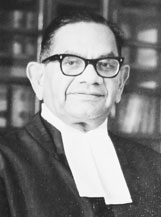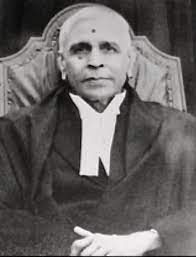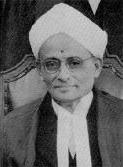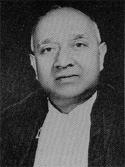The case of ‘Shankari Prasad Singh deo v. Union of India (1951)’, may be considered as first constitutional landmark case of India. This case arose after certain agrarian reforms carried out by government of India. These agrarian reforms were to abolish zamindari system in India. Against this, some zamindars preferred the writ petitions in Supreme Court. However, the supreme finally uphold the validity of these agrarian reforms.
Bench In the Case
From right to left- B.K. Mukherjea, Hirala Kania, N. Chandrasekhara Aiyar, M. Patanjali Shastri, Sudhi Ranjan Das,
Facts of the Case
Petitions were filed under Article 32 before the Supreme court of India. Those petitions raised the common question whether the Constitution (First Amendment) Act, 1951, which was passed by the provisional Parliament and purported to insert, articles 31A and 3lB in the Constitution of India was ultra vires and unconstitutional.
The then government which also had the majority in many states, carried out certain measures of agrarian reform in Bihar, Uttar Pradesh and Madhya Pradesh by enacting legislation which may compendiously be referred to as Zemindary Abolition Acts.
Certain zemindars, feeling themselves aggrieved, attacked the validity of those Acts in courts of law on the ground that they contravened the fundamental rights conferred on them by Part III of the Constitution.
The High Court at Patna held that the Act passed in Bihar was unconstitutional while the High Courts at Allahabad and Nagpur upheld the validity of the corresponding legislation in Uttar Pradesh and, Madhya Pradesh respectively. Appeals from those decisions were pending in Supreme Court. Petitions filed in Supreme Court by some other zemindars seeking the determination of the same question were also pending.
At that stage, the Union Government, with a view to put an end to all that litigation and to remedy what they considered to be certain defects brought to light in the working of the Constitution, brought forward a bill to amend the Constitution, which, after undergoing amendments in various particulars, was passed by the requisite majority as the Constitution (First Amendment) Act, 1951.
Swiftly reacting to that move of the Government, the zemindars brought the present petitions under article 32 of the Constitution impugning the Amendment Act itself as unconstitutional and void.
Contentions of the Counsels
Petitioners
- Article 368 of the Constitution is a complete code in itself. It does not contemplate any amendments to the Bill after its introduction. The Bill must be passed and assented to by the President as it was introduced without any amendment.
As the Constitution Amendment Bill was amended in several respects during its passage through the Parliament, the Constitution (First Amendment) Act was not passed in conformity with the procedure laid down in article 368 and is therefore invalid.
- When the Parliament exercises its ordinary legislative powers it has power to amend the Bills under articles 107, 108, 109(3) & (4). It has no such power when it seeks to amend the Constitution itself as article 368 does not give any such power.
- The power of amending the Constitution provided for under article 368 was conferred not on Parliament but on the two Houses of Parliament as a designated body and, therefore, the provisional Parliament was not competent to exercise that power under article 379.
There is a distinction between ordinary legislative power and power to amend the Constitution. The Article 368 vests the power to amend the Constitution not in the Parliament but in a different body, viz., a two-thirds majority of the two Houses of the Parliament.
- Article 392 gives power to the President to remove only such difficulties as arise in the working of the Constitution. “Any difficulties” sought to be removed by adaptation under that article must be difficulties in the actual working of the Constitution during the transitional period whose removal is necessary for carrying on the Government. It cannot be used to remove difficulties in the way of amending the Constitution that have been deliberately introduced by the Constitution. No difficulty could have been possibly experienced in the working of the Constitution on the very day the Constitution came into force.
- Parliament cannot seek to abridge the rights of property of the citizens guaranteed by Part III. As the present Act contravenes the provisions of Part III, it is void under article 13 (2). In any event, the new articles 31A and 3lB curtail the powers of the Supreme Court under articles 32, 132 and 136 and those of the High Court under article 226, and as such, they required ratification under clause (b) of the proviso to article 368 and not having been ratified, they are void and unconstitutional.
- They are also ultra vires as they relate to land, a subject matter covered by List II (see item 18) over which the State Legislatures have exclusive power. Parliament cannot make a law validating a law which it had no power to enact
- ‘ Law ‘ in article 13 (2) evidently includes all laws passed by the Parliament and must include laws passed under article 368 amending the Constitution.
- Article 13(2) is very wide in its scope and it invalidates all laws past, present and future which seek to curtail the rights conferred by Part III. It does not exempt laws passed under article 368 from its operation.
Union of India (Respondent)
- The donee of the power under article 368 is Parliament and the process of the passage of the Bill indicated in the said article is the same as that of ordinary legislative Bills. The article does not mean that the powers under article 368 are to be exercised by a fluctuating body of varying majority and not by Parliament. If the constituent authority and the legislative authority are two different entities the saving clauses in articles 2,3, 4 and 240, will be meaningless.
- Under article 379 (now deleted) provisional Parliament can exercise all the powers of Parliament; hence Provisional Parliament can act under article 368. “All the powers” in article 379 include power to amend the Constitution and there is no reason to restrict the import of these words by excluding amendment of the Constitution from their ambit.
- Article 13 (2) prohibits “laws” inconsistent with fundamental rights. It cannot affect article 368 since the word “law” in article 13 (2) refers to ordinary legislative enactments and not constitution making. The argument that the Bill to amend the Constitution should be passed as introduced, without amendments, is fallacious.
Provisions
As Article 379 has been deleted, we are referring it here for quick reference-
379. (1) Until both Houses of Parliament have been duly constituted and summoned to meet for the first session under the provisions of this Constitution, the body functioning as the Constituent Assembly of the Dominion of India immediately ‘before the commencement of this’ Constitution shall be the provisional Parliament and shall exercise all the powers and perform all the duties conferred by the provisions of this Constitution on Parliament.
Answers of the Court
On the question of parliament’s power to amend
The Constitution provides for three classes of amendments of its provisions, the simple majority, the 2/3rd majority and 2/3rd majority with states’ ratifications. The fact that a different majority in the same body is required for effecting the second and third categories of amendments cannot make the amending agency a different body.
There is no force, therefore, in the suggestion that Parliament would have been referred to specifically if that body was intended to exercise the power. Having mentioned each House of Parliament and the President separately and assigned to each its appropriate part in bringing about constitutional changes, the makers of the Constitution presumably did not think it necessary to refer to the collective designation of the three units.
On the question of various amendments in amendment bill
It is not correct to say that article 368 is a “complete code” in respect of the procedure provided by it. There are gaps in the procedure as to how and after what notice a bill is to be introduced, how it is to be passed by each House and how the President’s assent is to be obtained. Evidently, the rules made by each House under article 118 for regulating its procedure and the conduct of its business were intended, so far as may be, to be applicable.
Having provided for the constitution of a Parliament and prescribed a certain procedure for the conduct of’ its ordinary legislative business to be supplemented by rules made by each House (article 118), the makers of the Constitution must be taken to have intended. Parliament to follow that procedure, so far as it may be applicable, consistently with the express provisions of article 368, when they entrusted to it the power of amending the Constitution.
On the question of construction of article 392
The framers of the Constitution made the provision in article 392 conferring a general power on the President to adapt the provisions of the Constitution by suitably modifying their terms.
It had been urged, that the condition precedent to the exercise of powers under article 392 is the existence of difficulties to be removed, that is to say, difficulties actually experienced in the working of the Constitution whose removal would be necessary for carrying on the Government, such as for instance, the difficulties connected with applying articles 112, 113, etc., in the transitional period. But, the argument proceeds, constitutional amendments cannot be said to be necessary during that period.
The court said that difficulties are bound to arise in applying provisions. There was nothing in that article to suggest that the President should wait, before adapting a particular article, till an occasion actually arose for the provisional Parliament to exercise the power conferred by that article. Nor was there any question here of the President removing by his adaptation any of the difficulties which the Constitution has deliberately placed in the way of its amendment.
Therefore, the adaptation of article 368 by the President was well within the powers conferred on him by article 392 and was valid and constitutional.
Question on Article 13(2)
Article 13(2) which provides that,
“the State shall not make any law which takes away or abridges the rights conferred by this Part and any law made in contravention of this clause shall to the extent of the contravention be void.”
The argument was put thus:
“The State” includes Parliament (article 12) and “law” must include a constitutional amendment. It was the deliberate intention of the framers of the Constitution, who realized the sanctity of the fundamental rights conferred by Part III, to make them immune from interference not only by ordinary laws passed by the legislatures in the country but also from constitutional amendments.
It is not uncommon to find in written constitutions a declaration that certain fundamental rights conferred on the people should be “eternal and inviolate” as for instance article 11 of the Japanese Constitution. Article 5 of the American Federal Constitution provides that no amendment shall be made depriving any State without its consent “of its equal suffrage in the Senate.”
But the court said that, the framers of the Indian Constitution had the American and the Japanese models before them, and they must be taken to have prohibited even constitutional amendments in derogation of fundamental rights by using aptly wide language in article 13(2). Although “law” must ordinarily include constitutional law, there is a clear demarcation between ordinary law, which is made in exercise of legislative power, and constitutional law, which is made in exercise of constituent power.
Dicey defines constitutional law as including “all rules which directly or indirectly affect the distribution or the exercise of the sovereign power in the State.” It is thus mainly concerned with the creation of the three great organs of the State, the executive, the legislature and the judiciary, the distribution of governmental power among them and the definition of their mutual relation.
The terms of article 36a are perfectly general and empower Parliament to amend the Constitution, without any exception whatever. Had it been intended to save the fundamental rights from the operation of that provision, it would have been perfectly easy to make that intention clear by adding a proviso to that effect. In the context of article 13 “law” must be taken to mean rules or regulations made in exercise of ordinary legislative power and not amendments to the Constitution made in exercise of constituent power, with the result that article 13(2) does not affect amendments made under article 368.
Question on the validity of Article 31(A) and 31(B)
It was urged that, before these articles were inserted by the Amending Act, the High Courts had the power under article 226 of the Constitution to issue appropriate writs declaring the Zemindari Abolition Acts unconstitutional as contravening fundamental rights, and this Court could entertain appeals from the orders of the High Courts under article 132 or article 136.
As a matter of fact, some High Courts had. exercised such powers and this Court had entertained appeals. The new articles, however, deprive the High Courts as well as this Court of the power of declaring the said Acts unconstitutional, and thereby seek to make changes in Ch. 4 of Part V and Ch. 5 of Part VI. It was therefore submitted that the newly inserted articles required ratification under the proviso to article 368.
Article 31A aims at saving laws providing for the compulsory acquisition by the State of a certain kind of property from the operation of article 13 read with other relevant articles in Part III, while article 3lB purports to validate certain specified Acts and-Regulations already passed, which, but for such a provision, would be liable to be impugned under article 13.
It is not correct to say that the powers of the High Court under article 226 to issue writs “for the enforcement of any of the rights conferred by Part III” or of this Court under articles 132 and 136 to entertain appeals from orders issuing or refusing such writs are in any way affected. They remain just the same as they were before: only a certain class of case has been excluded from the purview of Part II/and the courts could no longer interfere, not because their powers were curtailed in any manner or to any extent, but because there would be no occasion hereafter for the exercise of their power in such cases.
Reference
Sri Sankari Prasad Singh Deo vs Union Of India: 1951 AIR 458, 1952 SCR 89





